
A solar battery system is a wise choice for homeowners seeking energy independence and peace of mind. As the demand for solar energy continues to rise, so does the importance of maximizing its potential to get the most from your investment.
Integrating a solar battery system into your home gives you a reliable and efficient means of storing excess solar energy for future use. A solar battery system enables you to maximize self-sufficiency, reduce reliance on the grid, and save money on your energy bills.

Benefits of Having a Solar System With A Battery Backup
A solar system with a battery provides a range of advantages, including:
- Lower electric bills: Storing and using your own solar energy leads to cost savings on your utility bills over time. In addition, a battery backup system could allow you to take advantage of time-of-use (TOU) pricing by storing energy when rates are lower and using it during peak-rate hours, helping optimize energy costs.
- Energy independence: The ability to generate and store your own electricity reduces reliance on the grid, increasing energy independence.
- Power during outages: In the event of a power outage, a solar battery backup system ensures that you have a reliable source of electricity, keeping essential appliances and devices powered up.
- Maximized solar energy usage: You can use stored solar energy at night or in cloudy weather, maximizing your solar panel system.
- Higher property values: Investing in a solar panel system with battery backup can increase the value of your home as renewable energy solutions continue to gain prominence and appeal in the market.
- Environmental benefits: Solar battery systems help reduce reliance on fossil fuels, lower carbon emissions, and contribute to a cleaner and more sustainable energy future.
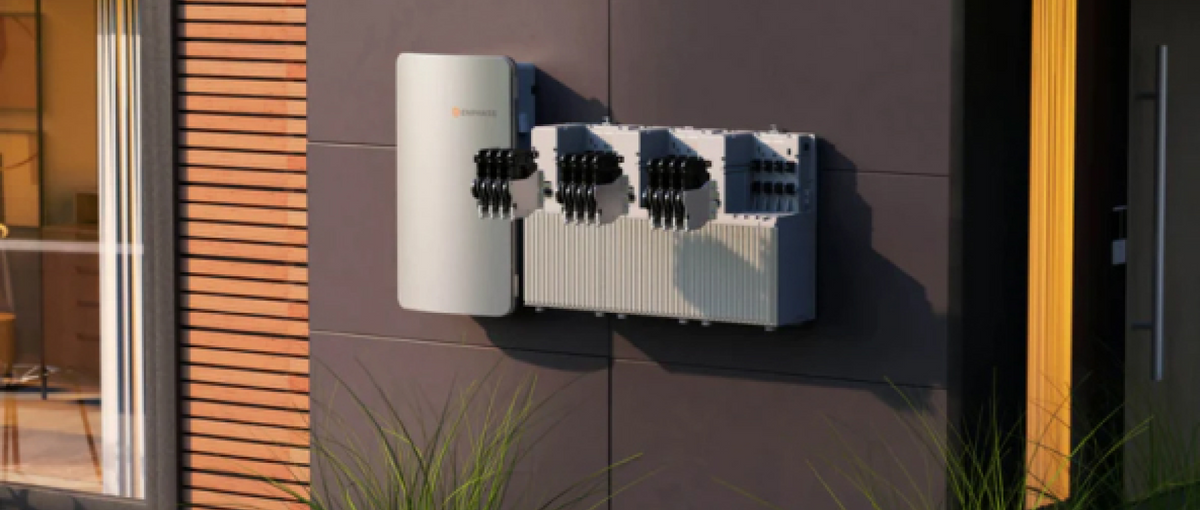
Things to Know Before Choosing a Solar Battery Storage System
You should consider a few things before choosing a solar battery system. From deciding between grid-tie and off-grid to evaluating solar battery types, we will arm you with the knowledge required to make the right buying decision for your home and energy future.
The Difference Between Grid-Tie vs Off-Grid
Grid-tie systems connect you to the public utility grid -- the entity you pay your electric bills to. If you've been paying an electric bill and then add solar panels to your home or business, you have a grid-tie system. Most people with access to power lines choose grid-tie systems.
During sunlight hours, your solar panels will power your building first, then charge your battery. Any extra energy will be exported to the grid and generate utility credits through the net metering program that is applicable to your state.
Unlike grid-tie systems, off-grid systems have an higher upfront investment. While this may sound desirable where bringing utility power is cost-prohibitive, it has drawbacks. Off-grid systems cost more than grid-tied systems but may be necessary to provide energy 24/7. In addition, off-grid systems make you 100% responsible for your power needs, requiring batteries and a generator to provide backup power in emergencies (and at night).
| Popular for properties with access to the grid | Best for properties without access to power lines |
| Provides energy to essential appliances when there is a power outage | The only solar option when there are power needs and there is no access to the grid |
| Uses a dual-function inverter to send excess energy to the grid and utilize stored battery power when utility rates are high or there is a power outage | Uses an inverter that supports a wide range of fossil fuel generators to provide redundancy |
Whole Home Backup vs. Partial Backup: Understanding Your Energy Needs
A whole-home battery backup system might sound like a good idea. A whole home battery backup system is viable for those with ample budgets seeking optimal user experiences during power outages. If you do not have any large electrical appliances, a whole home backup may be feasible.
However, setting up a partial home backup system is a more practical alternative. In this setup, you prioritize the essential appliances you wish to power during outages. You can achieve a more budget-friendly solution by creating a separate subpanel dedicated to these appliances.
Types of Solar Batteries
LFP (Lithium Iron Phosphate), NMC (Nickel Manganese Cobalt), and SLA (Sealed Lead Acid) batteries are three distinct technologies commonly used for energy storage purposes, each offering unique advantages and drawbacks.
- LFP batteries are known for their exceptional safety, long lifespan, and high tolerance for high temperatures, making them ideal for residential and industrial energy storage systems.
- NMC batteries, on the other hand, provide a higher energy density, making them more compact and suitable for electric vehicles and portable electronics. However, they are generally less tolerant of high temperatures and may have a shorter lifespan compared to LFP batteries.
- SLA batteries, while being a cost-effective option, are heavier, have lower energy density, and shorter lifespans compared to the other two options. They are often used in uninterruptible power supply (UPS) systems and smaller off-grid applications.
In recent years, LFP batteries have risen to prominence and become the most popular technology for energy storage applications. This popularity is mainly attributed to their price, remarkable safety features, long-lasting performance, and excellent thermal stability.
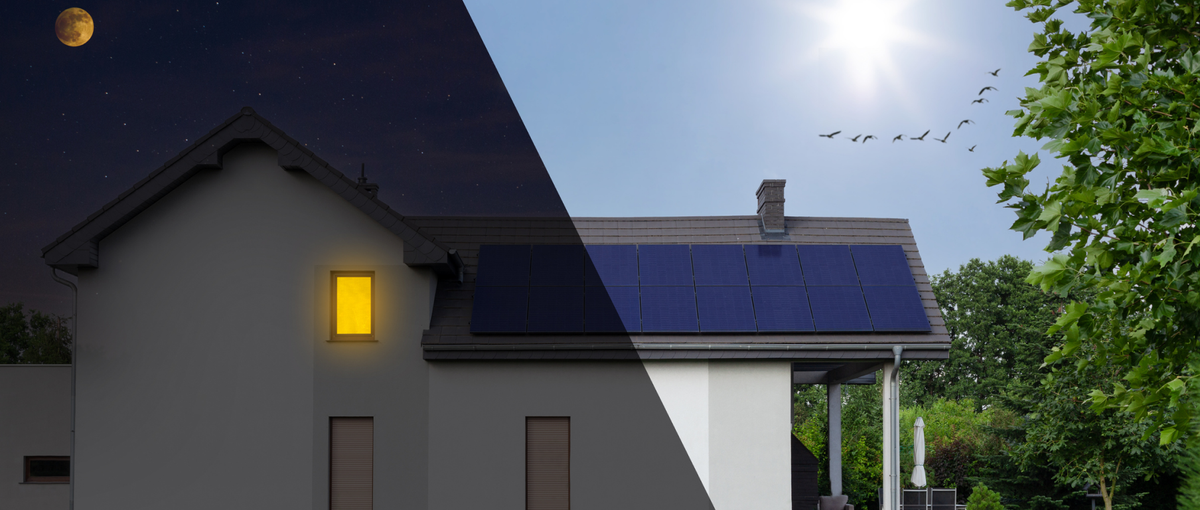
9 Factors to Consider When Buying Solar With Backup Battery
Here are nine factors to consider when choosing the components of a solar battery backup system for your home.
1. Capacity
Solar battery capacity, measured in kilowatt hours (kWh), indicates the amount of energy you can store. While kWh provides an overall measure of battery capacity, it's crucial to note that not all stored energy can be utilized entirely. Complete discharge can damage many battery types. The depth of discharge (DoD) a battery can tolerate depends on its chemical composition.
For instance, lead acid batteries typically have a DoD of around 50%, meaning they should not be drained beyond that point to maximize it's useful life. In contrast, the more popular lithium iron phosphate (LFP) batteries often have a DoD of approximately 90%, while maintaining a long useful life.
2. Cycle Life
LFP (Lithium Iron Phosphate) batteries are renowned for their impressive cycle life. These batteries can typically endure a significantly higher number of charge and discharge cycles compared to other lithium-ion battery chemistries. LFP batteries have an average cycle life ranging from 2,000 to 10,000 cycles, depending on the specific manufacturer, quality of materials, and operating conditions.
A cycle refers to one full charge and discharge of the battery. The cycle life of LFP batteries makes them an attractive option for applications that require frequent charge and discharge cycles. It's important to note that the cycle life of any battery can be influenced by various factors, including depth of discharge, charging and discharging rates, operating temperature, and overall battery management. Proper maintenance and adherence to recommended usage guidelines can further optimize the cycle life of LFP batteries, ensuring their reliable performance over many years.
3. Voltage
Low voltage batteries are characterized by their voltage levels below 100V but typically operate at 48V. Due to their lower voltage, these batteries provide less power compared to high voltage systems. The slower discharge rate of low voltage batteries can create challenges in meeting start-up loads, often necessitating support from the grid or solar sources to supply instant power.
This limitation is a significant drawback of low voltage systems. On the positive side, these systems are notably easier to install and upgrade, making them more accessible and cost-effective for various applications. Low voltage battery systems are exceptionally well-suited for off-grid living.
High voltage batteries represent a relatively recent advancement in the solar and storage industry. In comparison to low voltage batteries, high voltage solar batteries provide a higher discharge rate, enabling them to efficiently support and handle more significant load demands. Typically rated around 400V, these battery systems can charge and discharge at faster rates than their low voltage counterparts, effectively managing quick demand surges from starting equipment.
One advantage of high voltage batteries is that their elevated voltage levels eliminate the need for larger and costlier wiring. This enhances their overall efficiency when compared to low voltage systems. High voltage batteries are particularly well-suited for households or commercial properties with substantial energy demands. If you seek faster charging and discharging capabilities, a high voltage battery system is the ideal choice to meet your requirements.
4. Monitoring
Solar monitoring is essential for maintaining a healthy system and maximizing energy savings. Monitoring systems enable you to conveniently access real-time solar solar and storage system data from any internet-connected device and receive alerts to manage or optimize system performance.
5. Inverter Compatibility
If you’re adding a battery to an existing solar system, it’s essential to have an inverter that’s battery-ready, like Enphase microinverters or Sol-Ark Hybrid Inverters. Battery-ready inverters seamlessly connect and manage the flow of energy between the solar panels, the battery, and the electrical loads. They ensure efficient charging, discharging, and utilization of the stored energy, enabling a smooth and optimized operation of the solar backup battery system.
GoGreenSolar kits come with 100% compatible inverters and batteries, giving you one less thing to worry about.
6. Technical Support
When selecting a solar battery provider, the availability of reliable technical support must be considered. Getting help when you need it ensures a smooth and hassle-free experience throughout your solar battery system's installation, setup, and ongoing operation.
GoGreenSolar offers responsive and knowledgeable technical support and can promptly address any inquiries, troubleshoot issues, and provide expert guidance. Prioritizing a solar battery provider that offers robust technical support ensures peace of mind and maximizes the benefits of your investment in a solar and storage system.
7. Safety
Solar batteries store a significant amount of energy, and proper safety measures are necessary to prevent accidents or hazards.
Look for batteries that have undergone rigorous testing and certification to meet industry safety standards. Features like built-in protection against overcharging, overheating, and short circuits are crucial for safe operation. It is also vital to consider the battery's physical design, including proper ventilation and protection against environmental elements.
GoGreenSolar only offers batteries that conform the strictest UL safety standards including UL9540, UL9540A and UL 1973.
8. Price
The total cost for your battery backup system can vary depending on how much power and energy storage you need. Additionally, the cost can vary whether you’re installing a new solar system or adding batteries to an existing design.
To get an idea of total equipment cost, browse our battery backup kits here.
The cost of adding solar batteries that do a partial home backup starts at $10,000. This does not include any solar system components or installation costs. Whole home battery backup can cost $20,000 or more in batteries and related equipment, on top of the cost of your solar system.
9. Warranty
A robust warranty offers coverage against potential defects and ensures your solar equipment operates reliably for its intended lifespan. Warranties provide peace of mind by offering repair or replacement services in the event of unforeseen issues, ultimately safeguarding your financial investment and helping you derive long-term value from your solar system.
Here are typical warranties on various solar components:
- Solar panels and racking systems: 25-year warranty
- Batteries: Quality lithium batteries have 10-15 year warranties
- Inverters: 10 to 25-year warranty, depending on the brand
- Monitoring hardware: 1-5 warranty

Recommended Grid-Tie Solar Batteries: Our Pick
Enphase IQ battery technology is the culmination of years of research, design, development and testing, redefining solar battery reliability.
- Distributed architecture with no single point of failure
- Resistant to extreme temperatures and humidity based on semiconductor technology
- Passive cooling system with no moving parts

The Best Solar Battery Systems
Enhance your home's energy independence with the leading solar battery systems on the market today.
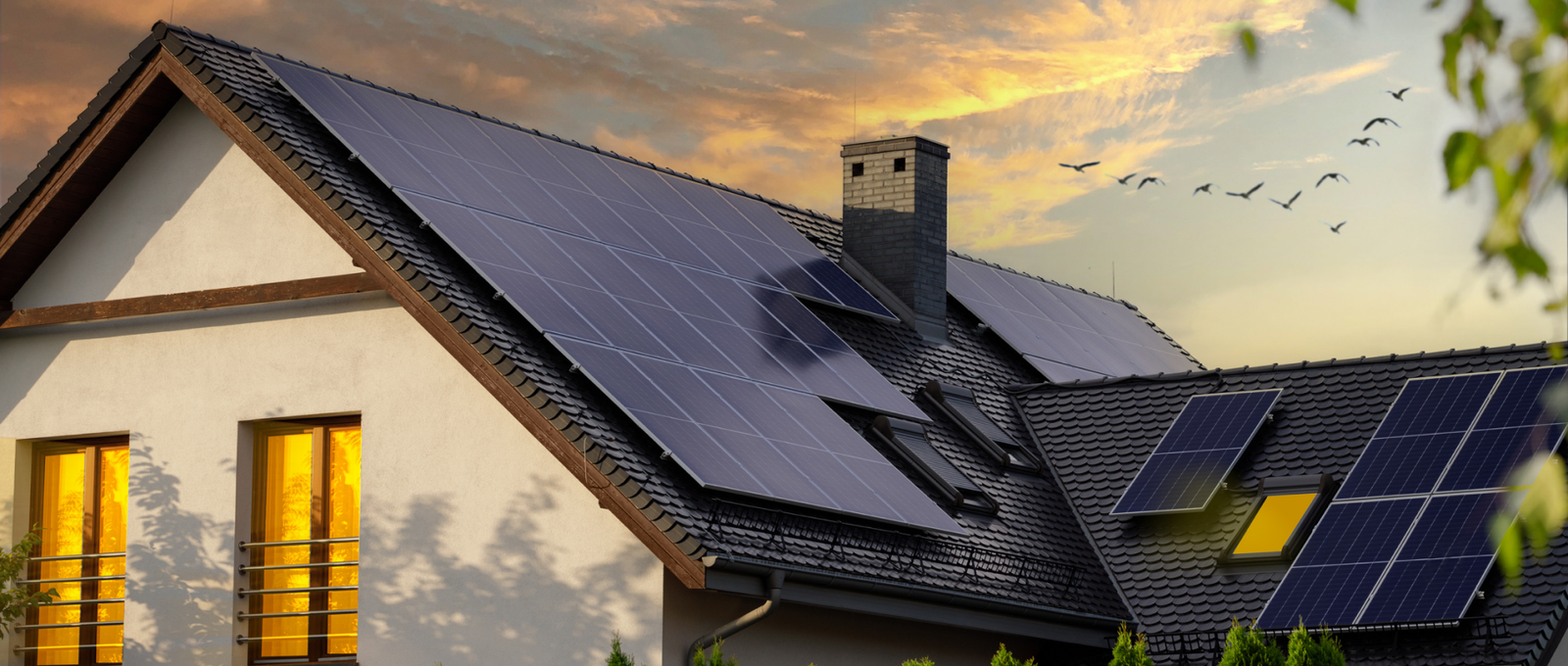
FAQs
Got questions? See answers to common questions about solar battery systems here.
Which battery chemistry is the best choice for my home?
LFP (Lithium Iron Phosphate) batteries have emerged as the top choice for solar and storage systems, owing to their exceptional performance and characteristics. These batteries offer a winning combination of safety, long lifespan, and high energy efficiency, making them ideal for storing excess solar energy and ensuring a reliable power supply.
LFP batteries are renowned for their robust thermal stability, reducing the risk of overheating or fire incidents, thus enhancing overall system safety. With an impressive cycle life ranging from 2,000 to 10,000 cycles, LFP batteries can withstand frequent charge and discharge cycles, providing consistent performance over many years. Their high energy density allows for compact designs, making them space-efficient and suitable for various installation settings.
There are three types of batteries under the lithium ion umbrella: pouch cells, cylindrical cells and prismatic cells. Prismatic batteries are often favored for the following reasons:
- Higher energy density: More energy storage in a compact size
- Efficient space utilization: Flat, rectangular shape optimizes space usage
- Improved thermal stability: Better heat dissipation capabilities
Check out our line of Enphase IQ solar battery kits using prismatic cell batteries.
Note: It’s important to carefully evaluate your requirements and consult a professional to determine the most appropriate battery type for your solar and battery system.
Read: The Different Types of Solar Batteries Explained
What is the potential return on investment?
A solar and storage system in California, operating under Net Energy Metering 3 (NEM 3), offers a compelling payback period of 5-7 years when installed as a DIY project. This attractive return on investment stems from the combination of solar panels generating electricity and the use of solar batteries to store excess energy for later use.
Solar batteries prove particularly advantageous in regions where utilities offer low export credits for backfed energy or have high time-of-use rates, allowing homeowners to optimize their energy usage and reduce reliance on the grid during peak periods. Beyond the financial benefits, the true value of incorporating solar batteries lies in the security and independence they provide. During blackouts or in areas with limited access to the power grid, solar batteries serve as a reliable backup power source, ensuring continuous electricity supply and peace of mind for homeowners.

Overall, a solar and storage system with the incorporation of solar batteries not only offers a promising financial return but also delivers resilience and energy security, making it a wise choice for forward-thinking homeowners in California and other areas with similar utility configurations.
Are any tax incentives or rebates available for installing a solar system with A battery backup?
Yes, various tax incentives and rebates are available for installing a solar system with battery backup. The availability and specifics of these incentives may vary depending on your state or local government. In many regions, homeowners can take advantage of a 30% federal tax credit through 2032, which provide a percentage deduction from their income taxes based on the solar system installation cost.
What installation options are available?
There are three options for installing solar panels or batteries:
DIY — A DIY solar project may not be as hard as you think. Taking the DIY route can save you thousands of dollars, and you can avoid the stress of finding a trustworthy installer.
Hybrid-DIY — Take a hybrid approach if a complete DIY project seems too daunting. Manage some parts of the installation process yourself, and seek professional help as needed. You’ll still be able to save some money and have some control over the installation.
Full professional installation — see our tips for picking a solar installer you can trust.
What is the difference between AC and DC Coupled?
AC (alternating current) and DC (direct current) coupled solar and storage systems are two distinct configurations for integrating solar panels with energy storage solutions.
In an AC-coupled system, the solar panels and the energy storage are connected to the AC side of the inverter. This setup allows for greater flexibility in the choice of solar panels and battery storage, as they can be installed independently and easily replaced or upgraded. Additionally, AC-coupled systems are well-suited for retrofitting existing solar installations with energy storage capabilities.
On the other hand, DC-coupled systems involve connecting the solar panels directly to the DC side of the battery inverter. In this setup, the solar panels' DC output is directly used for charging the batteries, which can result in slightly higher efficiency due to fewer conversion losses. DC-coupled systems are often preferred in scenarios where maximum energy capture and efficiency are crucial.
The choice between AC and DC-coupled solar and storage systems depends on the specific needs and goals of the installation. AC-coupled systems offer greater flexibility and are ideal for retrofitting or when the solar and storage components come from different manufacturers. DC-coupled systems, on the other hand, may be favored when efficiency and direct utilization of solar energy are critical considerations.
Understanding the advantages and limitations of each configuration helps in making the most appropriate choice for a particular solar and storage project.
| AC coupled | DC coupled |
|---|---|
|
Integrates into existing systems AC-coupled solar and storage systems are better suited for micro inverter setups or for integrating energy storage into existing solar installations. The flexibility of AC coupling allows easy addition of energy storage to an already installed micro inverter system without major modifications. |
Cost-effective DC-coupled systems can be more cost-effective, particularly in new installations. Since the solar panels and batteries share the same inverter, fewer components are needed, resulting in reduced installation and equipment costs. |
|
Reliable AC-coupled solar and storage systems are known for their reliability, contributing to their popularity in various applications. One key advantage of AC coupling is the ability to operate solar panels and energy storage components independently. In the event of a battery malfunction or failure, the solar panels can continue generating electricity, providing a reliable power source to the grid. |
Battery charging In DC-coupled systems, solar panels directly charge the batteries at the same voltage level, allowing for optimized charging and management of battery states. This setup can enhance the battery's lifespan and performance by precisely controlling the charging process, reducing the risk of overcharging or undercharging. |
|
Less efficient AC-coupled solar and storage systems can be less efficient due to additional energy conversions, which introduce conversion losses. |
More efficient DC coupled solutions are more efficient, as there is less energy loss in converting DC to AC energy to power your system. |
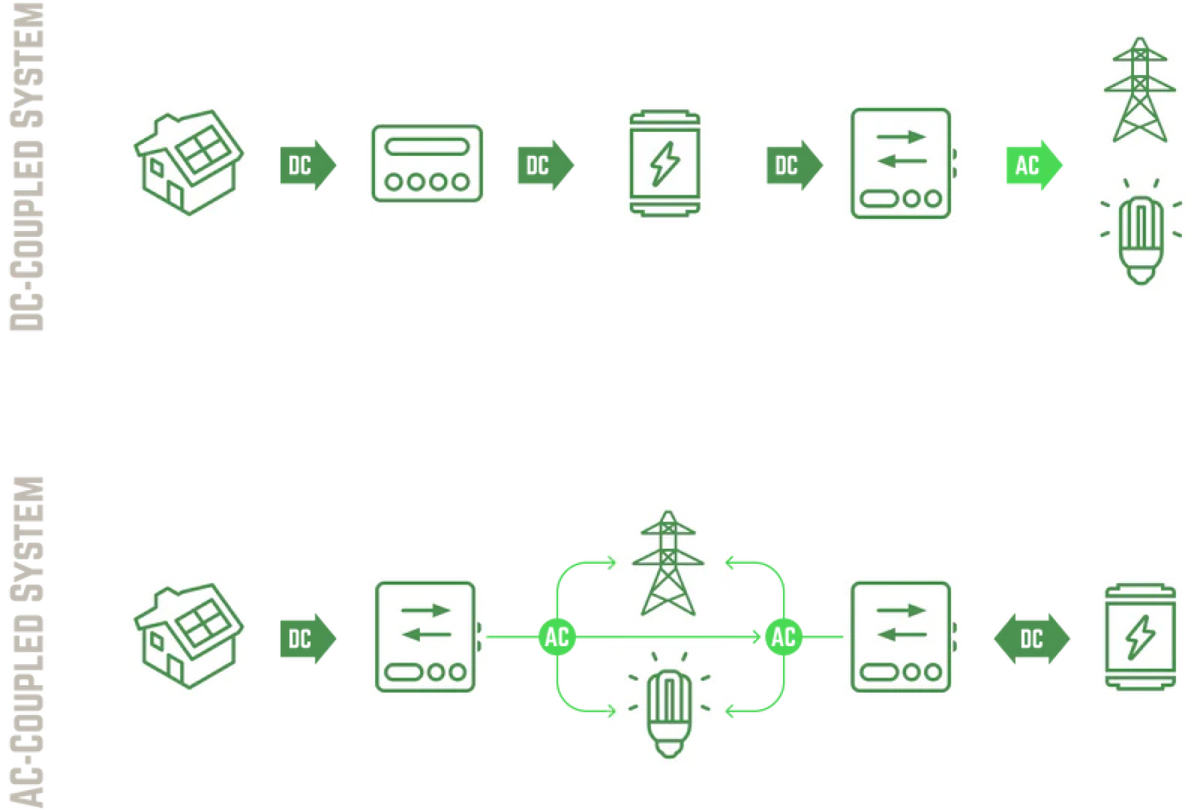

Shop Grid-Tie Solar Battery Kits for Your Home
Add a whole home or partial solar battery backup and enjoy long-term savings!
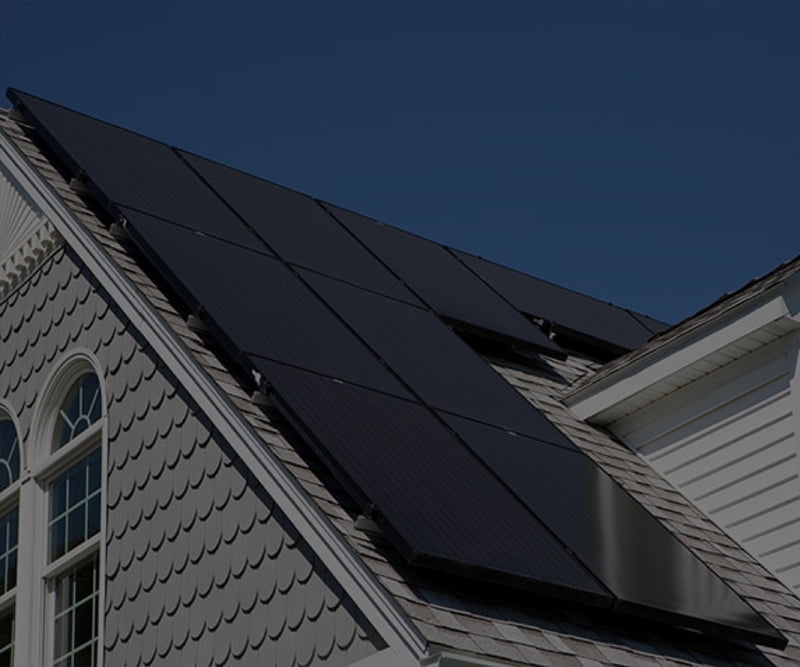
Solar Calculator

Which Solar Kit Do I Need?
GET STARTED WITH SOLAR
WE’LL HELP YOU FIGURE OUT YOUR SOLAR NEEDS!
Fill out the form for a complimentary solar quote that includes a custom satellite layout, system design and a breakdown of total project cost and estimated savings.
